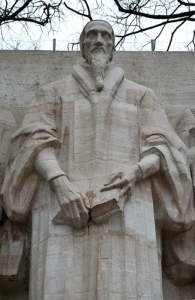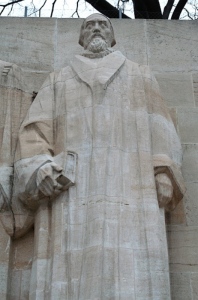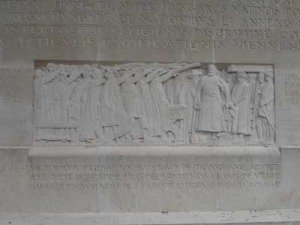The Reformation Wall Monument, Geneva
Reformation Wall (Mur des Réformateurs) is the international monument to the Reformation the great leaders of the Christian Reformation. The monument is located in Geneva Switzerland. The monument also includes important events and documents that changed the world as we know it today. The monument was built in 1909 for John Calvin’s 400th birthday.
Built into the old city walls of Geneva, the Reformation Wall overlooks the Parc des Bastions. Just a stone’s throw from the magnificent Place de Neuve in an exceptionally beautiful setting, the major figures of the Protestant Reformation are depicted as giant statues and bas-reliefs.
Separate on the left of the wall is a stone with Martin Luther’s name carved in it and separate to the right of the Wall is a stone with Huldrych Zwingli’s name carved in it. These stones are not a part of the wall because both Luther and Zwingli did begin the Reformed the church, only contributed to the reformation.
Behind the statues runs the motto shared by the Reformation and Geneva: Post Tenebras Lux (“After Darkness, Light”)
Take a Virtual Tour of the Reformation Wall
The main statues in the middle of the wall
 The main statues in the center of the Reformation Monuments are William Farel, John Calvin, Theodore Beza, and John Knox.
The main statues in the center of the Reformation Monuments are William Farel, John Calvin, Theodore Beza, and John Knox.
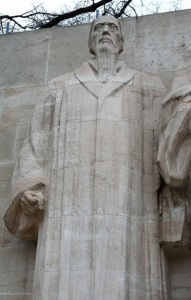
William Farel (1489–1565)
Founder of the Reformed Church in Neuchâtel, Berne, Geneva, and Vaud in Switzerland. He worked together with John Calvin to train missionaries across Europe.Farle was the father of the Reformation in France. A Tempestuous reformer from Gap, in the French Alps. He came to Geneva in 1532, and found many Reformation sympathizers. He was an encourager of Pierre Viret, the Swiss Reformer, and he persuaded Calvin to stay in Geneva as its Pastor.
John Calvin (1509–1564)
The undisputed leader of the Reformation. Building on Luther’s theology of grace through faith, he laid down the great principles of biblical religion, beginning with the knowledge of God, the creation, the fall, then redemption in Jesus Christ, the church, the sacraments, civil government, and the last things. He preached thousands of sermons and corresponded with hundreds of Christians in difficulty throughout Europe. He mainly influenced Presbyterian Church doctrine and Reformed theology. He began “Systematic Theology” with his book Institutes of the Christian Religion. John Calvin wrote one of the largest set of Bible commentaries during his time. He trained and sent missionaries across Europe.
Theodore Beza (1519–1605)
He was a disciple of John Calvin and later became John Calvin’s successor in Geneva. He further spread Reformed theology in France.Known by his Latin name, Beza, this scholar-statesman was well respected in the great courts around the Continent. In his hands he holds the Leges Academiae, the charter of the great school of Geneva, a training center for the persecuted ministers of the French-speaking world. He was the President of that school and its most effective professor. His theological writings, on a vast array of subjects, continue to benefit the church today.
John Knox (c.1513–1572)
Known by his Latin name, Beza, this scholar-statesman was well respected in the great courts around the Continent. In his hands he holds the Leges Academiae, the charter of the great school of Geneva, a training center for the persecuted ministers of the French-speaking world. He was the President of that school and its most effective professor. His theological writings, on a vast array of subjects, continue to benefit the church today. He sought freedom from persecution and studied under John Calvin after being declared an outlaw in England by Queen “Bloody” Mary. He later founded the Presbyterian church in Scotland.
Statues to the left of the main monument
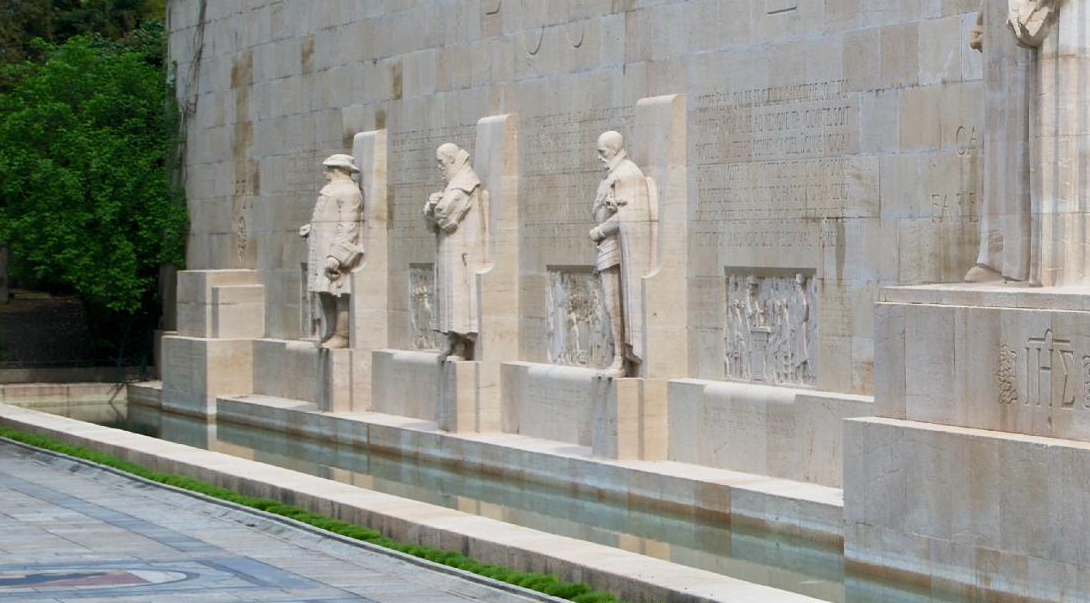 To the left of the middle statues are three smaller statues of William the Silent, Gaspard de Coligny, and Frederick William of Brandenburg.
To the left of the middle statues are three smaller statues of William the Silent, Gaspard de Coligny, and Frederick William of Brandenburg.
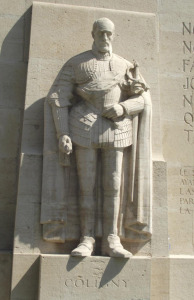 Gaspard de Coligny (1519 – 1572)
Gaspard de Coligny (1519 – 1572)
He was a French nobleman and admiral who lead the French Huguenot during the French Wars of Religion. He provided support and refuge for reformed protestants and helped those under religious persecution to escape. By the 1550s he had converted to Protestantism through the influence of his brother, d’Andelot. The first known letter which John Calvin addressed to him is dated 4 September 1558. The Coligny brothers were the most zealous and consistent aristocratic supporters of Protestantism in sixteenth-century France. He was as the leader of French Protestantism murdered with thousands of others during the St Batholomew’s day Massacre 1572. His surviving daughter married into the House of Orange and he was great great Grandfather of King William Prince of Orange.
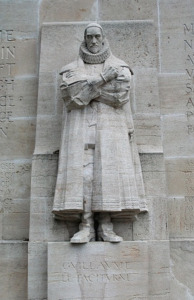 William the Silent (1533 – 1584)
William the Silent (1533 – 1584)
Also known as William the 1st of Orange was the major proponent of the Dutch war against the Spanish which led to the Eighty Years War between 1568–1648. The northern Low Countries declared independence from the Spanish king on July 26th, 1581. William married Lousie the daughter of Gaspard de Coligny and in turn became the leader of Protestant resistance in Europe and spent his life fighting for the freedom of his native land. His epitaph read ‘Father of the Fatherland’. He was the great grandfather of King William whose name he bore.
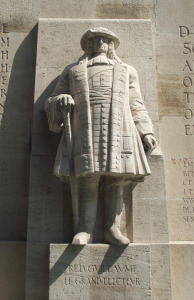 Frederick William of Brandenburg (1620 – 1688)
Frederick William of Brandenburg (1620 – 1688)
“Creator of the Brandenburg Tolerance Edict giving equal rights to Lutherans and Calvinists and the Potsdam Edict giving safety of passage to Brandenburg-Prussia to Huguenots after the Revocation of the Edict of Nantes (1620-1688). He settled some 20,000 Huguenot refugees from France in his domains and was a pillar of the growing Protestant Resistance movement across Europe which in the next generation was forged together by King William III Pince of Orange. He was King William’s uncle by marriage and this underscores just how orange blood flowed through the veins of many of the ruling protestant families in Europe and just why William Prince of Orange was chosen to lead the movement.
Statues to the right of the main monument
To the right of the middle statues are three smaller statues of Roger Williams, Oliver Cromwell, and Stephen Bocskay.
 Roger Williams (1603 – 1684)
Roger Williams (1603 – 1684)
He was an English Particular Baptist theologian that helped establish religious freedom and the separation of church and state. He founded the Providence Plantation colony in 1636 which was a baptist and other religious minority safe haven.
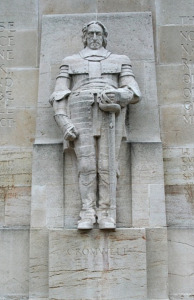 Oliver Cromwell (1599 – 1657)
Oliver Cromwell (1599 – 1657)
He was a “independent” puritan that became a dictator called the “Protectorate” in the British Isles between 1553 to 1558. He was a major proponent in the English Civil war and was a part of the establishment a commonwealth in England instead of a Royalty.
Stephen Bocskay (1557 – 1607)
He was a Hungarian Noble who was a Calvinist protestant. He went to war against the Habsburg Holy Roman Emperor’s who tried to force Roman Catholicism on Hungary. He promoted the religious freedom for Hungary and Transylvania in the Treaty of Vienna in 1606.
Carved Reliefs in the Wall
The following quotes are from BiblicalGeographic.com. “Along the wall are also reliefs depicting:”
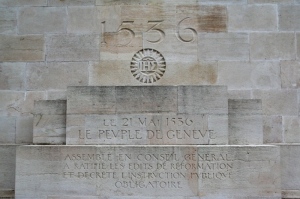 “An inscription commemorating Geneva’s official acceptance of the Reformation, 21 May 1536.”
“An inscription commemorating Geneva’s official acceptance of the Reformation, 21 May 1536.”
 An inscription stating Geneva maintained its independence from Savoy in December 12th 1602
An inscription stating Geneva maintained its independence from Savoy in December 12th 1602
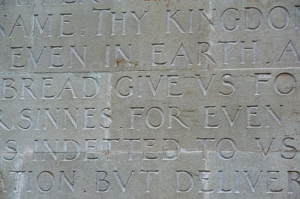 “Preaching of the Reformation to the people of Geneva in the presence of envoys from Bern. To the left is an inscription of the Lord’s Prayer in French.”
“Preaching of the Reformation to the people of Geneva in the presence of envoys from Bern. To the left is an inscription of the Lord’s Prayer in French.”
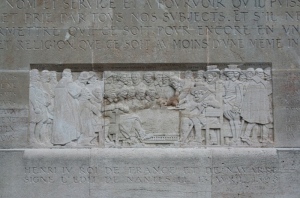 “King Henry IV (of Navarre) signing the Edict of Nantes (1598), which ended the Wars of Religion in France.”
“King Henry IV (of Navarre) signing the Edict of Nantes (1598), which ended the Wars of Religion in France.”
 “John Knox preaching against Queen Mary Stuart from his pulpit in St Giles Cathedral, Edinburgh. Above is an inscription of the Lord’s Prayer in English.”
“John Knox preaching against Queen Mary Stuart from his pulpit in St Giles Cathedral, Edinburgh. Above is an inscription of the Lord’s Prayer in English.”
 “Roger Williams and the Pilgrim Fathers praying on the Mayflower as it sails to America. Above is an inscription of the Mayflower Compact (1620).”
“Roger Williams and the Pilgrim Fathers praying on the Mayflower as it sails to America. Above is an inscription of the Mayflower Compact (1620).”
 The Glorious Revolution 1688 is commemorated by the relief of “The British Parliament presenting the Bill of Rights, an act declaring the rights and liberties of the subjects, also the settling the succession of the crown, to William and Mary, Prince and Princess of Orange in 1689.”
The Glorious Revolution 1688 is commemorated by the relief of “The British Parliament presenting the Bill of Rights, an act declaring the rights and liberties of the subjects, also the settling the succession of the crown, to William and Mary, Prince and Princess of Orange in 1689.”
This illustrates how the Reformation gave rise to the principles which in turn became enshrined in not only the modern British Constitution but the American Constitution. These Biblical principles of freedom and democracy were rediscovered at the Reformation and then translated from the context of church government to civil government. The Scriptural mandate and irresistible logic which saw the power of the Pope challenged and limited went on to challenge other secular tyrants and rulers.


